 |
|

|
 |
TABLE of CONTENTS
 |
Iconic Blatnik Bridge lights up Duluth after two-year, major rehabilitation project |
By Beth Petrowske, District 1 Public Affairs
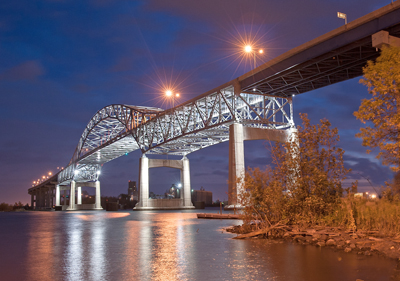
The original lighting system on the Blatnik Bridge only outlined the perimeter of the arch, the suspended deck and the approach spans. The new lighting system illuminates the structure from the inside out.
Photo by David Gonzalez
|
Two big light shows could be seen in Duluth the evening of Oct. 25. The first began with a majestic sunset in the western sky and the other took place at 6:25 p.m. when the new lighting system on the Blatnik Bridge was lit for the first time.
A time to celebrate
About 40 people gathered at the bridge to celebrate the completion of a two-year, major rehabilitation project that included a new energy-efficient lighting system. The lighting system is part of a larger $12.9 million rehabilitation project that includes improving the load-carrying capacity of the bridge, as well as making other improvements to simplify future maintenance work and allow for more thorough bridge inspections.
The 52-year-old bridge is the second-longest bridge in Minnesota and serves as a major link between Duluth, Minn., and Superior, Wis.
The celebration began with comments from Lt. Gov. Yvonne Prettner-Solon; Jeff Anderson from U.S. Rep. Rick Nolan’s office; MnDOT Commissioner Charlie Zelle; District Engineer Duane Hill and Duluth Mayor Don Ness.
“It’s very important to our community and to those of us who are responsible for our transportation system to do projects like this,” said Hill. “Particularly on the Blatnik Bridge, it’s important to make sure we do the rehabilitation necessary to ensure this bridge is going to provide the years of service we all expect.”
Hill thanked MnDOT project management, contract administration and design staff, MnDOT contractors and consultants, WisDOT and everyone involved in completing the project.
Lt. Gov. Yvonne Prettner-Solon, Commissioner Charlie Zelle, and District Engineer Duane Hill spoke during the Blatnik Bridge lighting ceremony Oct. 25.
Video produced by Joel Wenz
|
New lights brighten Duluth/Superior Harbor
In 2012, MnDOT formed a team of local and state officials to study new energy-efficient LED lighting for the bridge. Design concepts were developed by the Blatnik Bridge scoping team, which included MnDOT and WisDOT engineers and representatives from Allete/Minnesota Power. The team considered aesthetics, initial cost, operating cost and maintenance, durability and safety in preparing the designs.
MnDOT hosted an open house to solicit comments about the proposed lighting design alternatives. There was overwhelming support for the new illuminated design that is now installed on the bridge.
The new LED lighting system was designed by Ken Taillon, engineer, SEH Inc.
“Working with the team to understand MnDOT’s bridge and lighting maintenance practices and expectations played an important role in selecting the appropriate layout for the lighting and electrical system,” said Taillon. “The new system is designed to protect the luminaires and conduit system from the hazards of winter roadway salt spray and vibration. The state-of-the-art LED luminaires should provide many years of uninterrupted operation while realizing a 58 percent reduction in energy consumption over the original system.”
For more information about the Blatnik Bridge rehabilitation project, visit: mndot.gov/d1/projects/blatnikbridge/.
2013 state road construction program nears completion
Another construction season will soon be on the books as MnDOT crews wrap up work on dozens of projects statewide that improved Minnesota’s highways, bridges and other transportation infrastructure, making the ride from point A to point B smoother and safer for the travelling public.
Look for an update on the 2013 construction season in the Nov. 13 issue of MnDOT Newsline.
|
|
 |
|

|
 |
TABLE of CONTENTS
 |
Speed limits raised on three state highways in western Minnesota |
|
By TK Kramascz
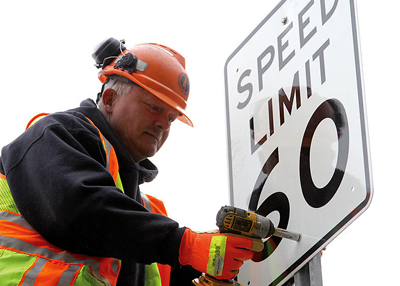
Dennis Salzwedel, Windom sign crew, places a new speed limit sign on Hwy 59 in western Minnesota. Speed limits were raised on three state highways last week after engineers determined the 60 mph speed was safe and reasonable for those roadways. Photo courtesy Aaron Hagen/Worthington Daily Globe |
MnDOT raised the posted speed limit from 55 mph to 60 mph on three highways in western Minnesota this month.
The changes on the entire length of Hwy 75, the majority of Hwy 59 and 14 miles of Hwy 7 in western Minnesota took effect Oct. 21, when the signs were posted. The State Patrol will enforce the new speed limit on these corridors.
Traffic engineers in Districts 2, 4, 7 and 8 studied the best “candidate” highways and found that the approximately 730 combined miles of Hwy 59, Hwy 75 and Hwy 7 met the necessary criteria.
“We did a careful and thorough study, looking at crash history, the way the roads are designed and what speed the traffic is actually traveling on the road,” said Sue Groth, state traffic engineer. “Sixty miles per hour was determined to be the safe and reasonable speed limits for these roadways.”
Hwy 75 enters Minnesota south of Luverne and runs through Pipestone, Canby and Breckenridge and is the main north–south route through Moorhead. It ends at the Canadian border north of Noyes.
Hwy 59 enters Minnesota south of Worthington and overlaps Interstate 94 near Fergus Falls. The route passes through Detroit Lakes and Thief River Falls before ending at the Canadian border north of Lake Bronson State Park and Lancaster. Two segments of Hwy 59 will remain posted at 55 mph between Clarkfield and Marshall and south of I-90 because of different roadway characteristics, including narrower shoulders and reduced sight lines.
Current speed zones through towns on both roadways will remain unchanged.
In addition, MnDOT raised the speed limit on the 14-mile segment of Hwy 7 between Hwy 75 near Odessa and Hwy 59 near Appleton.
In 2005, MnDOT raised speed limits from 55 mph to 60 mph on 930 miles of state highways. A study of these roads conducted last year found no negative safety impact.
“MnDOT is not in favor of increasing speed limits across the entire state,” Groth said. “When carefully selecting roadways with the proper characteristics, an increase in the speed limit can occur without negatively affecting overall safety.”
The state departments of Transportation, Health and Public Safety lead Minnesota’s Toward Zero Deaths traffic safety program. Each year, illegal or unsafe speed is a leading contributing factor in the state’s fatal crashes. Motorists are reminded that the posted speed limit is the maximum safe speed to travel under ideal conditions. All motorists are required to follow the basic speed limit law which states no person shall drive a vehicle on a highway at a speed greater than is reasonable and prudent under the conditions.
For more information on speed limits, visit mndot.gov/speed/index.html. |
 |
|

|
 |
TABLE of CONTENTS
 |
SPOT training at Camp Ripley |
By Rich Kemp
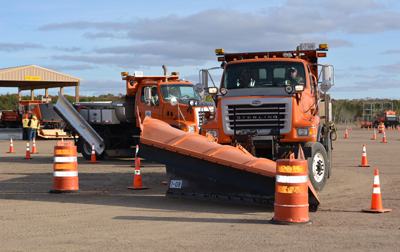
Student snowplow operators maneuver through the rodeo course at Camp Ripley Oct. 28. It was part of the SPOT training that took place in September and October. Photo by Rich Kemp |
Snowplow operators from around the state gathered at Camp Ripley in September and October for Snowplow Operators Training. This is the 10th year the training has been conducted at Camp Ripley.
“MnDOT has a great relationship with the Minnesota National Guard and Camp Ripley,” said Rick Shomion, training and development supervisor.
Staff from the Office of Maintenance and each district conducted the training and evaluations. New drivers have to pass three tests: a snowplow road test, a vehicle inspection test and a written motor carrier safety exam.
The two-week training program prepares the operators to clear Minnesota roads during the winter months. The first week starts with a train-the-trainer session, and then new drivers are brought in for classroom and hands-on training.
Ron Heim, Owatonna Truck Station, has been an instructor for nine years and works with outstate student operators.
“We start with pre-trips and truck inspections,” said Heim. “The students learn the controls so they don’t have to look at them and then they get behind the wheel to practice driving in the rodeo course on Camp Ripley. After practicing around Camp Ripley, they go on the county roads and then practice driving in Little Falls.”
The training areas provide an invaluable experience to operators who have never driven before in snow and ice conditions. SPOT is a detailed course of instruction building safe drivers, all of whom operate on the same standards and techniques. Each operator works through a variety of safety measures, plowing techniques and best-practiced procedures related to winter highway maintenance operations.
There were 92 students in the first session in September, and 88 in the October training. Although all of the students in this year’s training are MnDOT employees, previous courses have included snowplow operators from cities and counties.
“It is well-organized and is good training,” said Brian McCalley, Rochester Truck Station. “It has given me the confidence to hit the road when the first snow arrives.”
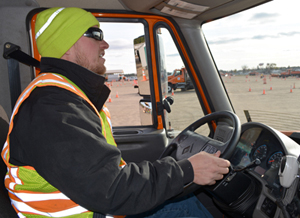
Adam Hovden, Rochester Truck Station, was one of 88 students who participated in the SPOT training at Camp Ripley in October. Photo by Rich Kemp |
Adam Hovden, Rochester Truck Station, operated snowplows on city roads before joining MnDOT in July.
“I have driven plows before, but I learned quite a bit,” said Hovden. “The training has been really beneficial. It takes a lot of practice. When I get back to the truck station, I will drive a truck around to learn my route.”
Normally Camp Ripley is busy with soldiers, tanks and other military vehicles. However, during the SPOT training, the orange snowplows are a dominant sight around the post.
"I was impressed with the ingenuity of MnDOT within the training area," said Col. Scott St. Sauver, Camp Ripley post commander. "Snowplow training in September didn't seem feasible without snow, but they used sand and develop some of the most experienced operators on the road."
"Camp Ripley is perfect for training new operators," said Shomion. “It is centrally located for all the districts. It also offers a large number of low-volume roads on which to train and has all the amenities that are necessary, including the training area, classrooms and billeting.”
Keeping the roads clear of snow and ice is a high priority for MnDOT during Minnesota winters. The many hours spent around the plows during the two weeks of SPOT training will help with the plowing of more than 12,000 miles of state highways and interstates in Minnesota, which equals about 30,000 lane miles. |
 |
|

|
 |
TABLE of CONTENTS
 |
Employees may sign up for insurance benefits Nov. 1-14 |
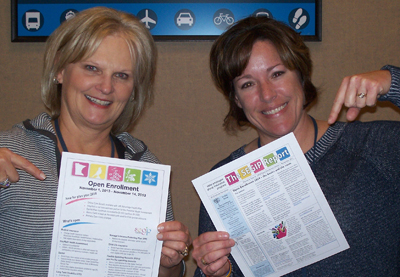
From left: LaVonne Nicolai and Robin Jordan are the open enrollment coordinators for District 7. Photo by Mary Slater |
Employees who want to make changes to their insurance benefits can do so during open enrollment, Nov. 1-14.
This year employees may change their medical and dental insurance carriers and add or drop dependent coverage. Employees may also enroll in or increase long-term disability, child life insurance, pre-tax plans, and reduce the elimination period by one 30-day unit for the Manager’s Income Protection Plan.
Employees currently participating in the pre-tax plans for medical and dental expense accounts, dependent care expense accounts and the transit expense account must re-enroll for 2014.
In addition, employees who complete a personal health assessment during the open enrollment period and accept a health coach call will receive lower office visit copayments in 2014. Register for an account at StayWell.
For more information, contact your open enrollment coordinator:
- District 1 - Jessica Leslie, 218-725-2713
- District 2 - Carol Dudgeon, 218-755-6502
- District 3 - Cindy Asleson, 320-223-6504
- District 4 - Tammy Maijala, 218-846-3646
- District 6 - Debbie Tlougan, 507-286-7569
- District 7 - Robin Jordan, 507-304-6122; LaVonne Nicolai, 507-304-6113
- District 8 - Dawn Oie, 320-214-6427
- Metro District - Susan Vang, 651-234-7418; Jeannette Peters, 651-234-7425
- Central Office - Deborah Staples, 651-366-3405; Julie Gore, 651-366-3376; Connie Eystad, 651-366-3398
|
 |
|

|
 |
TABLE of CONTENTS
 |
Southeast Minnesota, Twin Cities metro region gain new TZD coordinators |

Jessica Schleck is the new TZD coordinator in Southeast Minnesota. Photo by Kristine Hernandez |
Jessica Schleck is the new Southeast Minnesota Toward Zero Deaths coordinator, and Susan Youngs is the new coordinator in the Twin Cities metro region.
Schleck worked as a health educator at Dodge County Public Health since 2006. In that position, she worked with the Dodge County TZD Safe Roads grant for three years, creating the TZD Safe Roads county coalition and coordinated with worksites and driver educators to promote traffic safety and policies.
In May, Schleck coordinated the regional seat belt mobilization news conference and photo shoot.
She has an associate degree from Rochester Community College in Science and Human Services and is certified as a Child Passenger Safety Technician. She is based in Rochester.
Youngs joins MnDOT, MnDPS and the entire traffic safety community with a background in communications, public involvement, educational outreach campaigns and event coordination. She assisted MnDOT, local transportation partners and traffic safety stakeholders on many projects.

Susan Youngs is the new TZD coordinator in the Twins Cities metro region. Photo by Rich Kemp |
She was the public information coordinator for the Hwy 22 roundabouts in Mankato. She developed an extensive roundabout educational campaign providing safety benefit fact sheets and hands-on learning tools.
Youngs developed and implemented the public communication strategy for the Hwy 10/Hwy 59 reconstruction project in Detroit Lakes, the I-494/Hwy 169 design build, and I-35W/Crosstown project. She also provided leadership for public information events for the Northstar Commuter Rail.
Youngs has a Bachelor of Arts in English and Speech Communications and a Master of Arts in Literature. Her office will be located in the Water’s Edge in Roseville.
|
 |
|

|
 |
TABLE of CONTENTS
 |
On the Job: Inspecting bridges with Jennifer Zink |
By TK Kramascz
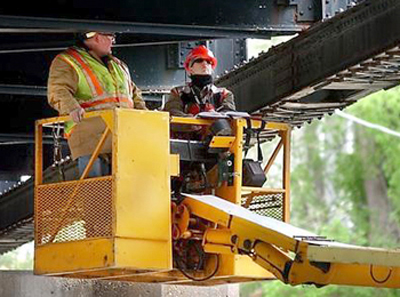
Jennifer Zink inspects Bridge 4930 – Hwy 99 spanning the Minnesota River near St. Peter. Photo courtesy of the St. Paul Pioneer Press |
You think your job takes you to dizzying heights? We spent some time with Jennifer Zink, a principal engineer at the Bridge Office who heads up inspections, and found out what it’s really like up there. This hockey-playing mom (a goalie, no less) grew up in Ironwood, Mich., and received her bachelor’s degree in Civil Engineering at Michigan Tech in Houghton.
In a nutshell, describe your office’s basic responsibilities and your specific responsibilities.
I work at the Bridge Office’s fracture critical inspection unit as the lead principal inspection operations engineer. The Bridge Office provides structural and hydraulic leadership for all MnDOT districts, consultants and other units of government, with services for the design, construction and maintenance of Minnesota's bridges and structures.
I supervise seven inspection employees, which include engineers, specialists and technicians. I’m the key expert in bridge inspection operations and non-destructive inspection technologies. I work with district inspection personnel, Bridge Office functional units, local agencies and other MnDOT offices to ensure that bridges in Minnesota are inspected and managed at the highest level of quality. Other areas of responsibility include:
- Inspection Operations – Fracture Critical and Special Inspection Program
- Bridge Inspector Training and Non-Destructive Testing Certification Program
- National Bridge Inspection Standards Program
- Bridge Asset Management (Assessment and Preservation)
I began working at MnDOT in 2001 and received my master’s degree in infrastructure systems engineering from the University of Minnesota in 2009.
What are you working on right now?
We’re getting toward the end of the inspection season and I’ll be inspecting the St. Anthony Parkway Bridge in Minneapolis very soon. I’m also working on our automated bridge inspection project that began in 2009, which is called SIMS – Structure Information Management System, which was initiated from my master’s program capstone project.
What does a typical day look like?
A typical day consists of being out in the field inspecting a bridge or in the office writing reports, returning phone calls, completing timesheets…basically catching up on administrative work. Whether out in the field or in the office, I’m always connected via laptop or cell phone. I can take inspection photos, check and send email, write reports or be on a conference call anytime or anywhere due to the technological resources at our disposal.
Is there a “busy” time of year? If so, what/when is it?
When isn’t it busy? From spring through autumn I inspect fracture critical bridges all over the state, which involves a lot of coordination and travel. During the winter months I review inspection reports, update manuals and policy, develop and provide statewide training to inspector and plan for the next inspection season.
What challenges do you face?
Weather and nature! During inspection season I face the many challenges of weather, which include hot and cold temperatures, wind, rain and even snow sometimes. (It’s necessary to dress in layers constantly.) I also encounter those bridge residents—wasp nests, giant spiders, angry falcons, owls, mosquitos, snakes and way too many pigeons.
In highly populous areas such as the Twin Cities and Duluth, inspection access is limited to hours outside of rush hour and sometimes to overnight and weekends because of traffic volume.
Since the 35W bridge collapse, extensive changes have taken place in bridge inspection and maintenance practices both statewide and nationally—such as more frequent inspections, more extensive reporting, proactive maintenance and automated data collection.
What’s most rewarding about the job?
I have the best job in the world! I get to travel this beautiful state, work outdoors, meet and work with many people and ultimately ensure bridge safety. Our inspection program is highly regarded nationwide and around the world. I’ve had numerous inquiries and presentation requests from other states and countries due to our groundbreaking inspection procedures, policies and technologies.
What’s your favorite part of the job?
My favorite part is having the ability to work outdoors on our numerous bridges alongside the different district and local agency bridge owners. I’ve come to know many great inspectors, maintenance workers and engineers in this capacity. I also enjoy assisting other states and countries that inquire about our program’s developments and achievements.
Do you or a co-worker have an interesting job to share with readers? Click here to send us your ideas, and we’ll contact you for more information.
Recent employee profiles:
|
 |
|

|
 |
TABLE of CONTENTS
 |
Four more communities receive Bicycle Friendly designation |
By Sue Roe
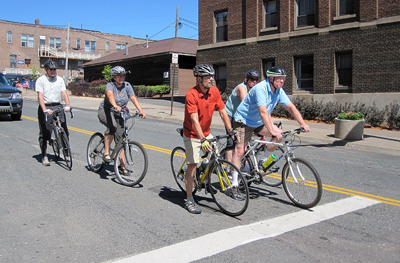
Duluth participated in one of the Office of Transit’s bicycle and pedestrian workshops to find ways to improve its biking programs and facilities. Participants rode around the city as part of the workshop. Duluth received a 2013 Bicycle Friendly Community recognition from the League of American Bicyclists. The Office of Transit conducts the workshops in coordination with the Bicycle Alliance of Minnesota and the Department of Health. Photo courtesy of Metropolitan Interstate Council |
The League of American Bicyclists recognized Duluth, Grand Marais, Richfield and Winona with Bicycle Friendly Community awards on Oct. 15. These four cities join Bemidji, Grand Rapids, Mankato, Minneapolis, Rochester and St. Paul as communities that are improving conditions for bicycling through investment in bicycling promotion, education programs, infrastructure and pro-bicycling policies.
The awards not only signify that more communities are committed to providing and improving their transportation systems for commuter and recreational bicyclists, but that strong partnerships exist between state agencies, such as MnDOT, and local and statewide groups.
“Bicycling plays an important role in Minnesota’s multimodal transportation system,” said Commissioner Charlie Zelle. “When MnDOT plans improvements to the state’s transportation system, bicycling is an important consideration. These awards recognize communities that are enhancing the contributions bicycling makes to economic, social, health and environmental benefits.”
The Office of Transit’s bicycle and pedestrian section, the Department of Health and Bicycle Alliance of Minnesota offer workshops to help communities find ways to improve their biking programs and facilities. About 20 workshops were conducted around the state during the past two years.
“Sometimes it’s striping a bike lane or placement of a sign that helps communities improve their bike friendliness,” said Lisa Austin, bicycle and pedestrian planner. “The bike friendly program application is a hard one to complete. It’s an existing tool communities can use to find out what they need to improve their bike friendliness and ultimately the quality of life and health in their communities. We’re happy to support it and it helps MnDOT meet some of its performance measures,” she added. |
 |
|

|
 |
TABLE of CONTENTS
 |
What’s new on the web |
By Becky Dahlberg Bridges and Structures
The bridges and structures website was recently redesigned and now has a cleaner look and feel with easier navigation. Find bridge design, construction and maintenance resources on the mobile friendly site using your smartphone or tablet, and learn more about how the Bridge Office provides structural and hydraulic leadership for district offices, consultants and other units of government to maintain Minnesota’s bridges and structures. mndot.gov/bridge/
State Aid
The State Aid for Local Transportation site was recently updated. Improvements included:
- Adding headers and subheaders, making it quicker and easier to find information
- Removing old, out-of-date documents
- Combining smaller pages into a single page and organizing them by category
- Enhanced viewing for smartphones and tablets
Find local transportation resources and learn more about how SALT works with local levels of government to help ensure a safe, effective and coordinated highway network at mndot.gov/stateaid/.
|
 |
|

|
 |
TABLE of CONTENTS
 |
You’re one click away from helping tell MnDOT's story |
By Bob Filipczak, social media coordinator
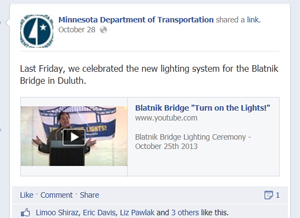
Sample post from the MnDOT Facebook page. |
By now, most of you have heard Commissioner Charlie Zelle talk about the importance of getting our story out to the public. It’s easy to forget that we can do this every day, in a number of ways, through the power of social media. And it’s often just one click away.
MnDOT uses social media—Facebook, Twitter and YouTube—to tell our story. Sometimes that’s an earlier-than-expected completion of a project, or a picture of our cable median barriers stopping a car from a head-on collision, or our plows getting ready for a storm.
MnDOT plasters these stories, photos and videos all over social media so we can show our followers the hard work we do on their behalf. Currently we reach about 20,000 followers through all our accounts, but you can help us reach more people. If, for example, you share a Facebook post from MnDOT on your own wall, all your connections get to see that post, too. If you retweet something we tweet, all of your followers see it, too. You can see how that could accelerate the momentum of our stories pretty quickly.
Here are two steps you can take to extend the reach of MnDOT’s stories:
Like or follow us—On Facebook, if you “like” MnDOT, you will see what we are posting. If you follow us on Twitter, you will see what we are tweeting. The social media hub will show you all of the different topics you can choose from.
Share or retweet—Once you see what we are up to on social media, you can let your friends and family know by sharing a post from Facebook or retweeting something you see on Twitter. You can also click on other options, but these two are the most effective ways to let others see our stories.
We are not asking you to share everything with everyone you know. But, if we run a video of one of our flaggers, and you work for Maintenance, it might make sense to share it with your friends. Or if you work in the Bridge Office, you might want to share what’s going on at the St. Croix Crossing or Dresbach bridge construction. You get the idea.
MnDOT does some very important and interesting work as an agency. We are getting the word out. Thanks for helping us extend our reach. |
 |
|
| |
|



